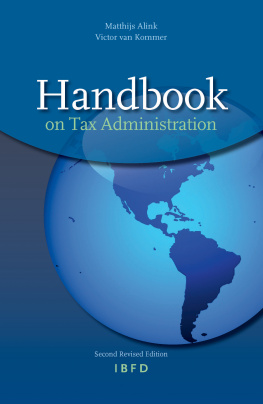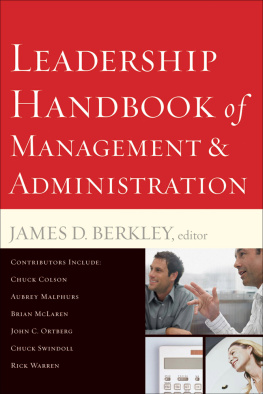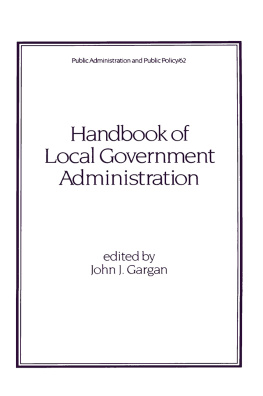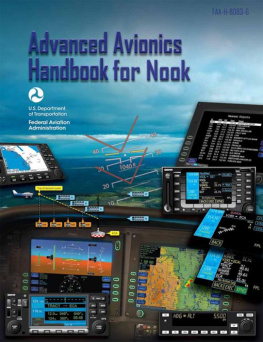Matthijs Alink - Handbook on tax administration
Here you can read online Matthijs Alink - Handbook on tax administration full text of the book (entire story) in english for free. Download pdf and epub, get meaning, cover and reviews about this ebook. year: 2013, publisher: IBFD, genre: Politics. Description of the work, (preface) as well as reviews are available. Best literature library LitArk.com created for fans of good reading and offers a wide selection of genres:
Romance novel
Science fiction
Adventure
Detective
Science
History
Home and family
Prose
Art
Politics
Computer
Non-fiction
Religion
Business
Children
Humor
Choose a favorite category and find really read worthwhile books. Enjoy immersion in the world of imagination, feel the emotions of the characters or learn something new for yourself, make an fascinating discovery.
- Book:Handbook on tax administration
- Author:
- Publisher:IBFD
- Genre:
- Year:2013
- Rating:5 / 5
- Favourites:Add to favourites
- Your mark:
- 100
- 1
- 2
- 3
- 4
- 5
Handbook on tax administration: summary, description and annotation
We offer to read an annotation, description, summary or preface (depends on what the author of the book "Handbook on tax administration" wrote himself). If you haven't found the necessary information about the book — write in the comments, we will try to find it.
Handbook on tax administration — read online for free the complete book (whole text) full work
Below is the text of the book, divided by pages. System saving the place of the last page read, allows you to conveniently read the book "Handbook on tax administration" online for free, without having to search again every time where you left off. Put a bookmark, and you can go to the page where you finished reading at any time.
Font size:
Interval:
Bookmark:
Handbook on Tax Administration
Second Revised Edition
Matthijs Alink
and
Victor van Kommer

IBFD
Visitors address:
Rietlandpark 301
1019 DW Amsterdam
The Netherlands
Postal address:
P.O. Box 20237
1000 HE Amsterdam
The Netherlands
Telephone: 31-20-554 0100
Fax: 31-20-622 8658
www.ibfd.org
2015 IBFD
All rights reserved. No part of this publication may be reproduced, stored in a retrieval system or transmitted in any form or by any means, electronic, mechanical, photocopying, recording or otherwise, without the written prior permission of the publisher. Applications for permission to reproduce all or part of this publication should be directed to: permissions@ibfd.org.
Disclaimer
This publication has been carefully compiled by IBFD and/or its author, but no representation is made or warranty given (either express or implied) as to the completeness or accuracy of the information it contains. IBFD and/or the author are not liable for the information in this publication or any decision or consequence based on the use of it. IBFD and/or the author will not be liable for any direct or consequential damages arising from the use of the information contained in this publication. However, IBFD will be liable for damages that are the result of an intentional act ( opzet ) or gross negligence ( grove schuld ) on IBFDs part. In no event shall IBFDs total liability exceed the price of the ordered product. The information contained in this publication is not intended to be an advice on any particular matter. No subscriber or other reader should act on the basis of any matter contained in this publication without considering appropriate professional advice.
Where photocopying of parts of this publication is permitted under article 16B of the 1912 Copyright Act jo. the Decree of 20 June 1974, Stb. 351, as amended by the Decree of 23 August 1985, Stb. 471, and article 17 of the 1912 Copyright Act, legally due fees must be paid to Stichting Reprorecht (P.O. Box 882, 1180 AW Amstelveen). Where the use of parts of this publication for the purpose of anthologies, readers and other compilations (article 16 of the 1912 Copyright Act) is concerned, one should address the publisher.
ISBN 978-90-8722-340-3 (print)
ISBN 978-90-8722-339-7 (eBook)
NUR 826
Tax Administrations implement and enforce tax laws. These laws are designed to achieve domestic goals and are drafted in a domestic context and from a domestic perspective. Tax laws are primarily aimed at taxing domestic subjects and objects to raise revenue for domestic public expenditures. Taxpayers, however, increasingly operate internationally. As a consequence, taxation has evolved into a global issue. Tax Administrations should therefore cooperate to increase the effectiveness and efficiency of their approaches and operations.
Tax Administrations need to collaborate with each other both on a bilateral basis and through international organizations. Good cooperation requires trust and understanding based on knowledge about the legislation, the stages of social and economic development of the country and its culture, the strategic objectives and the procedures and methods of the other party. Tax Administrations can also learn from each other. Although all Tax Administrations operate in different contexts, characterized by the specific features of the countries in which they operate, they all face similar challenges in achieving their goals. Therefore, active participation in international organizations on tax administration can be very beneficial.
This Handbook has evolved over time. Its initial version, Handbook for Tax Administrations, Organizational Structure and Management of Tax Administrations , was published in 2000. It was the result of intensive collaboration between tax managers and tax policymakers from Latin, Central and North America and Europe, representing various CIAT member countries. This collaboration was initiated by CIAT inviting the Netherlands to lead two different working groups one on organizational structure of tax administrations and another on management of tax administrations and to write a Handbook for Tax Administrations based on the input provided by the members of these working groups. The then Director-General of the Dutch Tax and Customs Administration, Joop van Lunteren, was delighted to accept the invitation and assigned the responsibility for this project to us. The initial publication has been widely used by tax administrators, both in CIAT member countries and in non-member countries all over the world, as well as by universities for academic purposes.
When presenting the Handbook in 2000, Joop van Lunteren stressed the uniqueness of the product in the sense that it reflected a first attempt to provide a systematic description of the structure and management of Tax Administrations, based on the input and experiences of participants stemming from such different societies in terms of tradition, culture, economy and taxation.
In our justification of the initial version of the Handbook, we clearly stated that given the many differences in traditions and cultures, sizes and populations of countries, economic and social factors, legislations and institutional factors the book does not aim to provide a blueprint or a best practice of tax administration. No general blueprint or best practice of tax administration exists. What works well in one country can totally fail in another country, and what is feasible in one country is not in another, because the circumstances may be too different or the preconditions are not met. However, Tax Administrations do have much in common and they can learn a lot from each other both from the successes and from the failures of others. Therefore, exchanging views and experiences on policies and practices in the area of tax administration can be very beneficial for tax administrators and policymakers. This book aims to contribute to that by providing a broad and comprehensive overview of tax administration, illustrated by numerous examples and descriptions of different approaches.
For the publication of the Handbook on Tax Administration in 2011 we reviewed the initial version of the book entirely, after consulting a working group hosted by Argentina consisting of users of the book from Tax Administrations in a number of CIAT member countries and in close collaboration with the staff of the CIAT executive secretariat. Based on the responses of the working group and the CIAT executive secretariat and other input, we have significantly expanded the content of the Handbook by adding a chapter on tax policy, principles of taxation and the history of taxation, by extending the description of compliance behaviour of taxpayers and compliance risk management (including the specific characteristics of different categories of taxpayers), by describing the primary processes of tax administration and issues such as integrity and ethics in much more detail, and by many other adjustments. As a result, the size of the book has more than doubled and its scope has widened from a Handbook on Organizational Structure and Management of Tax Administration into a Handbook on Tax Administration , covering the entire tax administration spectrum.
The Handbook on Tax Administration 2011 was very well received and has been used in many countries. The book was translated into Chinese by SAT, the Chinese Tax Administration, which added a third language to the English and Spanish versions. Because of the success of the book our publisher, IBFD, invited us to provide a new updated and revised edition of the book, which we are very happy to present. This new edition of the Handbook on Tax Administration provides more details on a variety of topics, including effectiveness of taxation and tax expenditures, tax competition and BEPS, globalization, e-commerce, trends in inequality of income and wealth (HNWIs), social media, research on compliance behaviour, corporate governance and tax avoidance, integration of social security contributions, and the roles and responsibilities of ombudsmen and national audit offices. The section on audit provides more information on audit theory, understanding of businesses, third-party information, case selection for audit, whistle-blowers, Internet search tools, identity theft and tax fraud, money laundering and FATF, but also the shift from traditional audit to real-time management and self-control. The section on HRM provides more introductions on this topic and the section on cultural dimensions of management was updated and extended. Lastly, a new chapter is included that provides a diagnostic tool for Tax Administrations to assess and measure their institutional, strategic and operational ability to implement, administer and enforce the tax laws and other tasks assigned to them.
Next pageFont size:
Interval:
Bookmark:
Similar books «Handbook on tax administration»
Look at similar books to Handbook on tax administration. We have selected literature similar in name and meaning in the hope of providing readers with more options to find new, interesting, not yet read works.
Discussion, reviews of the book Handbook on tax administration and just readers' own opinions. Leave your comments, write what you think about the work, its meaning or the main characters. Specify what exactly you liked and what you didn't like, and why you think so.












